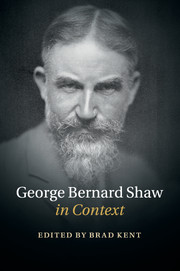Book contents
- Frontmatter
- Dedication
- Contents
- List of illustrations
- Notes on contributors
- Preface
- Acknowledgements
- A Chronology of Shaw's Works
- List of abbreviations
- PART I PEOPLE AND PLACES
- PART II THEATRE
- PART III WRITING AND THE ARTS
- PART IV POLITICS
- PART V CULTURE AND SOCIETY
- 31 Celebrity
- 32 Education
- 33 Evolutionary theory
- 34 Health and vegetarianism
- 35 Language
- 36 Nature
- 37 Philosophy
- PART VI RECEPTION AND AFTERLIFE
- Further reading
- Index
- References
31 - Celebrity
from PART V - CULTURE AND SOCIETY
Published online by Cambridge University Press: 05 October 2015
- Frontmatter
- Dedication
- Contents
- List of illustrations
- Notes on contributors
- Preface
- Acknowledgements
- A Chronology of Shaw's Works
- List of abbreviations
- PART I PEOPLE AND PLACES
- PART II THEATRE
- PART III WRITING AND THE ARTS
- PART IV POLITICS
- PART V CULTURE AND SOCIETY
- 31 Celebrity
- 32 Education
- 33 Evolutionary theory
- 34 Health and vegetarianism
- 35 Language
- 36 Nature
- 37 Philosophy
- PART VI RECEPTION AND AFTERLIFE
- Further reading
- Index
- References
Summary
Celebrity reverberates throughout Bernard Shaw's writings and reception, animating his authorial persona and inflecting his work. The degree to which such components of celebrity as repute and recognisability shape Shaw's legacy is apparent from his contemporaries’ encounters with him. Hugh Kingsmill, for example, depicts the power of Shaw's celebrity in a 1931 anecdote: ‘I entered the lift, which contained three women, and as it began to descend, I saw Mr. Shaw smiling benignly down on me. “Bernard Shaw,” the three women gasped. It was an impressive moment’. Kingsmill had been visiting Shaw to challenge Frank Harris's defamation of Oscar Wilde as a ‘drunkard and swindler’. His account thus reads as a rumination on renown; it points to a cultural fascination with celebrity, the phenomenon emerging, during the late 1800s and the first half of the 1900s, in the form we recognise it now.
Shaw's life and career coincided with this explosion of twentieth-century celebrity culture: a drastic shift in the way celebrities are created, who gets created as one, and the significance of renown. Literary fame, especially the brand of modernist authorship practiced in and around the 1920s, a flagship decade for Shaw, participated in these transformations. Shaw, not immune to cultural sea change, became a totem of individuality, an icon whose self-production parallels that of the greatest celebrities and the most exemplary modernist writers of his time. In a typical, if hyperbolic, instance of Shaw celebrification, a 1930 magazine feature terms him ‘as venerable an institution as Queen Victoria at the time of her diamond jubilee’. Shaw's renown is measurable by his 1923 Time cover, and his Nobel and Oscar awards – a cross-section of acclaim achieved by only him, still. It is graspable from his public associations, across diverse spheres of influence, with Albert Einstein, Winston Churchill, Margaret Sanger, Danny Kaye, and Gene Tunney – and from his dummy at Madame Tussaud's.
During Shaw's lifetime, fame increasingly settled itself on people and professions that would earlier have been unlikely to achieve widespread recognition: figures from cultures of mass entertainment rather than state- or society-authorised hierarchies of achievement. Probably the most seminal account of this change is Leo Löwenthal's 1943 study of twentieth-century biographies, which notes a ‘considerable decrease of people from the serious and important professions and a corresponding increase of entertainers’.
- Type
- Chapter
- Information
- George Bernard Shaw in Context , pp. 255 - 264Publisher: Cambridge University PressPrint publication year: 2015



